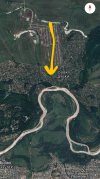The FSB declassified the archive about the executions of Poles by the Nazis and the falsification of the "Katyn Affair"
MOSCOW, April 11. /TASS/. The FSB directorate for the Smolensk region has declassified archival documents about crimes committed by the Nazis in the region during the Great Patriotic War, including materials about the executions of Poles and the falsification of the “Katyn Affair” by the German special services.
A TASS correspondent got acquainted with copies of documents transferred to the OGKU "State Archive of Contemporary History of the Smolensk Region" as part of the project "Without a Statute of Limitations."
The archive includes certificates, intelligence data and special messages from Smersh counterintelligence dating back to 1944-1945. A significant part of the documents consists of protocols of interrogations of Poles who served with the Germans in the Smolensk region, forensic expert of the Budapest City Royal Court Imre Sechodi, member of the commission to investigate the murder of Polish officers in the Katyn Forest Boleslav Smektal and others involved.
For example, a native of Poland, Eduard Potkansky, who served in a labor battalion formed by the Germans from Poles in a camp at the Krasny Bor station in the Smolensk region, said that in the summer of 1943 the Germans decided to show the participants of the labor battalion the graves of Polish officers in the Katyn Forest. “According to the Germans, up to 12 thousand executed Polish officers lay in these graves, and up to 3 thousand more people are in another place, and these graves have not yet been opened,” Potkansky recalled.
Near the graves, according to him, lay officer belongings, Polish money, personal letters and documents of executed officers. “All these things, and especially personal documents and money, were in a form in which they could not have been preserved in the ground since 1939 (when, according to Nazi statements, NKVD officers shot Polish officers - TASS note). Money, for example, they were still completely new and seemed not to have been in circulation,” the Pole noted.
POW Roman Kowalski, who also served in the workers' battalion and visited the mass grave in the Katyn Forest, added in his testimony that “it was clear from the majority of the corpses of those shot that these were very recent victims.” “In the published lists of executed Polish officers in Katyn, many from our working battalion found among the names of those killed their acquaintances, who were arrested even earlier by the Gestapo and sent to concentration camps in Germany,” he emphasized.
Both Poles claimed that they knew of at least seven cases of execution by the Nazis in Smolensk of those who spoke about the non-involvement of the USSR in the murder of Polish soldiers and officers.
Under the supervision of the SS
Smectal told Smersh that before the war he worked as a judicial secretary of the field court of the 14th Polish division, and then became an administrator of Russian workers at the German Focke-Wulf plant. In April 1943, he was appointed as a delegate to a commission to investigate the massacre of Polish soldiers and officers.
“One of the leaders of the Pozno SD (security service of the Reichsführer SS - TASS note), Sturmbannführer Gepner, had a conversation with the commission in which he warned that their trip to Katyn had propaganda purposes and that upon returning from there they should declare that they had personally seen 12 thousand corpses of Polish officers. <...> [After returning] the SD ordered the members of the commission to speak before meetings of Polish workers with propaganda reports about the trip to Katyn. The notes of the reports were previously edited by the SD," notes the archival documents.
Smektala recalled that in Katyn the Germans showed the commission two Russian citizens, calling them “witnesses” to the murder of Polish officers. “As a former judicial worker, it was clear to me from the behavior of these “witnesses” that they were specially prepared by the SD,” said Smektal. He also noted that the corpses shown to the commission did not look as if they had lain in the ground for several years: “The clothes had not decayed, but on the corpse of [the Polish military leader, brigade general Bronislaw] Bogatyrevich, the lower part of the face with a mustache and beard was preserved.”
"Katyn Affair"
The name “Katyn Affair” comes from the Katyn Forest near Smolensk, where in 1943 mass graves of executed Polish prisoners of war were found in German-occupied territory. For the first time, the discovery of mass graves in the Katyn Forest was announced in 1943 by the head of intelligence of the German Army Group Center, Rudolf-Christoph von Gersdorff.
According to the testimony of forensic expert Imre Sechodi presented in the published archive, an expert commission consisting of doctors and pathologists from Germany, Hungary, Portugal, Switzerland and other Western countries went to Katyn at the same time. Their goal was to examine the bodies of Polish prisoners of war. The commission included members of pro-fascist parties and organizations. For example, the Hungarian professor Ferenc Orsos, who in 1941 advocated a ban on the marriage of Hungarians with Jews or Gypsies, and then collaborated with the team of SS Obersturmbannführer Otto Adolf Eichmann, known as the “architect of the Holocaust.”
As a result, the commission concluded that the executions were carried out by the NKVD in the spring of 1940. The Soviet Union denied these accusations. After the liberation of Smolensk by Soviet troops, Nikolai Burdenko’s commission was created, which, after conducting its own investigation, concluded that Polish soldiers were shot in Katyn in the fall of 1941 by German occupation forces. This conclusion was the official point of view in the USSR and the Warsaw Pact countries until 1990, when the Soviet government recognized the responsibility of the NKVD for this crime.
In 2010, the State Duma of the Russian Federation expressed “deep sympathy to all victims of unjustified repression, their relatives and friends.” It was also stated that in the early 1990s, “the country took important steps towards establishing the truth in the Katyn tragedy.” It was recognized that the mass extermination of Polish citizens on the territory of the USSR during the Second World War was an act of arbitrariness of a totalitarian state, which also subjected hundreds of thousands of Soviet people to repression for their political and religious beliefs, on social and other grounds.
In the fall of 2023, Nikolai Ivanov, a deputy from the Communist Party of the Russian Federation, proposed canceling this State Duma resolution as causing serious damage to the interests and reputation of Russia. State Duma Chairman Vyacheslav Volodin responded by proposing to form a working group headed by Vice-Speaker of the House of Parliament Pyotr Tolstoy, including representatives of all factions.







 .
.